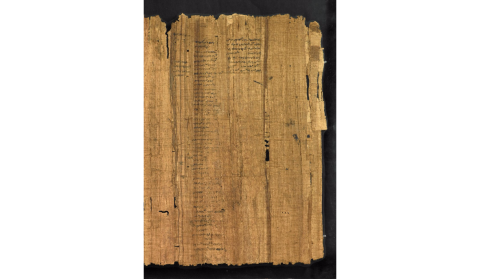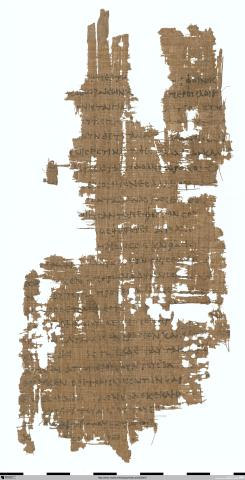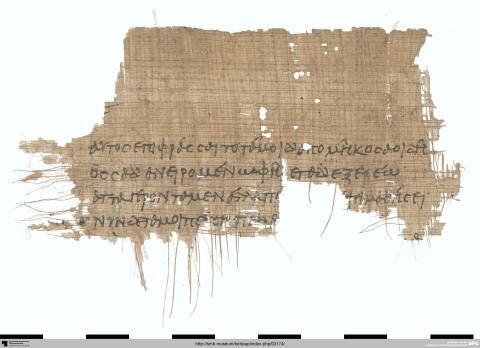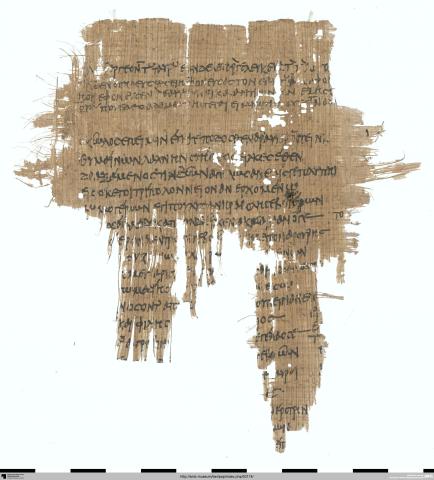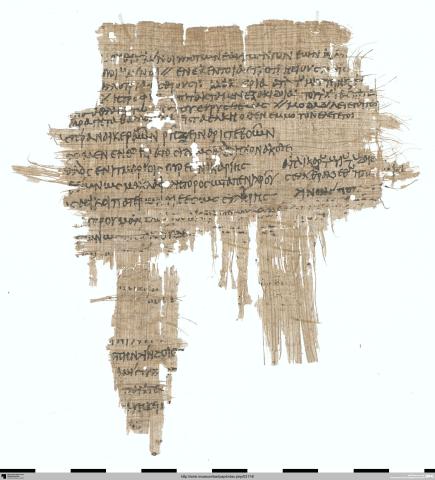Scholia
P.Lond.Lit. 181 Fr. 1 Scholia to Callimachus
Annotations
A papyrus of four rolls, originally used for farm accounts, to which was later added the Constitution of Athens (Athenaion Politeia) attributed to Aristotle, a portion of a commentary on Demosthenes' speech against Meidias, and scholia on Callimachus' Aetia. The fourth, fragmentary roll was formerly listed by the British Museum as Papyrus 131* (see Catalogue of Additions 1894), but this separate designation is no longer in use. Folio references on Digitised Manuscripts refer to the parts into which the papyrus is now divided at the British Library, and not to the original rolls (roll 1 = ff 1-2; roll 2 = f 3; roll 3 = f 4; roll 4 = f 5). In addition, for ease of use, the commentary on Demosthenes' In Midiam, which is upside down relative to the text of the Constitution of Athens, has been inverted and added as f 2cv, and the scholia on Callimachus' Aetia has been similarly inverted and added as f 2cr.
Contents: Three columns of fragments of scholia on Callimachus's Aetia (Σ Lond. = frr. 1d, 2a, and 2e Harder), copied in the 1st century AD on the recto of col. 11 of the Constitution. Published in Milne 1927 and Harder 2012.3.
P. Berol. 11521
Annotations
Inhalt:
Scholien (= Fr. 21b Harder) zu ausgewählten Lemmata aus Kallimachos, Aitia I Fr. 7c, 8f, 11–16 Harder über die Geschichte der Argonauten mit Zitaten aus Homer, Ilias 13, 685; Kleidemos, Atthis (FGrHist 323 F 13 Jacoby); Pindar Fr. 349 Snell-Maehler.
Publikation:
U. von Wilamowitz-Moellendorff, Neues von Kallimachos, SPAW 1912, 544–547.
Properties
P. Berol. 11629 A verso
Annotations
Kallimachos, Aitia I, Fr. 23 Harder mit Scholien (Fr. 23c) und Fr. 24 Harder mit Scholien (Fr. 25d) und Aitia III, Fr. 54h und 54i Z. 18–22 Harder.
Publikation:
U. von Wilamowitz-Moellendorff, Neues von Kallimachos II, SPAW 1914, 222–244; SH 264 (Fr. a R) und 265 Z. 18–22 (Fr. a V) (H. Lloyd-Jones - P. Parsons).
Weitere Literatur:
C. Austin, L’Apothéose d’Arsinoé (P.Berol. 13417 A = Callim. Fr. 228 Pf.) in: Bastianini - Casanova, Callimaco, cent’anni di papiri 57–68, insb. 58.
Properties
P. Berol. 11629 A recto
Annotations
Kallimachos, Aitia I, Fr. 23 Harder mit Scholien (Fr. 23c) und Fr. 24 Harder mit Scholien (Fr. 25d) und Aitia III, Fr. 54h und 54i Z. 18–22 Harder.
Publikation:
U. von Wilamowitz-Moellendorff, Neues von Kallimachos II, SPAW 1914, 222–244; SH 264 (Fr. a R) und 265 Z. 18–22 (Fr. a V) (H. Lloyd-Jones - P. Parsons).
Weitere Literatur:
C. Austin, L’Apothéose d’Arsinoé (P.Berol. 13417 A = Callim. Fr. 228 Pf.) in: Bastianini - Casanova, Callimaco, cent’anni di papiri 57–68, insb. 58.
Properties
P. Berol. 11629 B verso
Annotations
Kallimachos, Aitia I, Fr. 23 Harder mit Scholien (Fr. 23c) und Fr. 24 Harder mit Scholien (Fr. 25d) und Aitia III, Fr. 54h und 54i Z. 18–22 Harder.
Fr. a Rekto: 22 Zeilen; Fr. a Verso: 19 Zeilen; Fr. b Rekto: 5 Zeilen; Fr. b Verso: 5 Zeilen.
Publikation:
U. von Wilamowitz-Moellendorff, Neues von Kallimachos II, SPAW 1914, 222–244; SH 264 (Fr. a R) und 265 Z. 18–22 (Fr. a V) (H. Lloyd-Jones - P. Parsons).
Weitere Literatur:
C. Austin, L’Apothéose d’Arsinoé (P.Berol. 13417 A = Callim. Fr. 228 Pf.) in: Bastianini - Casanova, Callimaco, cent’anni di papiri 57–68, insb. 58.
Properties
P. Berol. 11629 B recto
Annotations
Kallimachos, Aitia I, Fr. 23 Harder mit Scholien (Fr. 23c) und Fr. 24 Harder mit Scholien (Fr. 25d) und Aitia III, Fr. 54h und 54i Z. 18–22 Harder.
Fr. a Rekto: 22 Zeilen; Fr. a Verso: 19 Zeilen; Fr. b Rekto: 5 Zeilen; Fr. b Verso: 5 Zeilen.
Publikation:
U. von Wilamowitz-Moellendorff, Neues von Kallimachos II, SPAW 1914, 222–244; SH 264 (Fr. a R) und 265 Z. 18–22 (Fr. a V) (H. Lloyd-Jones - P. Parsons).
Weitere Literatur:
C. Austin, L’Apothéose d’Arsinoé (P.Berol. 13417 A = Callim. Fr. 228 Pf.) in: Bastianini - Casanova, Callimaco, cent’anni di papiri 57–68, insb. 58.
Properties
PSI XI 1219 Scholia on Callimachus Aetia Book 1
Annotations
From PSI online:
The papyrus comes from excavations conducted by E. Breccia at Behnesa (Kom Ali-el-Gammâm) in the spring of 1932. It was possibly part of the private library of the family of Sarapion, the so-called "Apollonian." See I. Crisci, “La collezione dei papiri di Firenze”, in D.H. Samuel (ed.), “Proceedings of the Twelfth International Congress of Papyrology” (American Studies in Papyrology, VII), Toronto 1970, p. 93.
The papyrus has been edited by M. Norsa and G. Vitelli, “Da papiri della Società Italiana. 1. Frammenti di Scolii degli Αιτια di Callimaco,” in BSAA 28 N.S. (Tomo VIII, II fasc.), 1933, pp. 123-132, plate at p. 142.
A date in the first to the third century AD was proposed in LDAB 0498.
Additional editorial comments in R. Pfeiffer, “Callimachus. Fragmenta” I, Oxford 19652, Schol. Flor. ad frr. 1, 2, 3-7, 7, 19, 22-25; G. Massimilla, “Callimaco. Aitia. Libro primo e secondo”, Pisa 1996, pp. 62-63, 71-72, 76, 79, 97.
Further Bibliography: PSI XI 1219 intr.; Pack2 196; A. Körte, “Literarische Texte mit Ausschluss der christlichen. Nr. 795”, in Archiv XI, 1935, pp. 229-230; V. Bartoletti, “Die italianische Papyrusforschung der letzten zehn Jahre”, in Lipz.Roman.Stud III/2, 1937, p. 47 (= V. Bartoletti, “Scritti 1933-1976” I,1, Pisa 1993, p. 47); R. Goossens, “Το κάτιсκον των ποιημάτων (P.S.I., XI, n° 1219, fr. 1, l. 8)”, in CdÉ XVII/35, 1943, pp. 134-137; L. Torraca, “Il prologo dei Telchini e l’inizio degli Aetia di Callimaco” (Collana di studi greci 48), Napoli 1969, pp. 17-19; G. Arrighetti, “Hypomnemata e scholia: alcuni problemi”, in MPhL 2, 1977, pp. 49-67; C. Meillier, “Callimaque, Aitia, fr.1, v.7, et l’unité probable des fragments 1 (Invective) et 2 (Songe)”, in ZPE 33, 1979, pp. 39-40; M. Del Fabbro, “Il commentario nella tradizione papiracea”, in Stud.Pap. XVIII/2, 1979, pp. 79-80, 123, nt. 105, p. 127, nr. 99; K. McNamee, “Abbreviations in Greek Literary Papyri and Ostraca” (BASP, Suppl. 3), Ann Arbor 1981, pp. XXXV, 32, 120; McNamee, “The long and short of Callimachus Aetia Fr. 1.9-12”, in BASP XIX/1-2, 1982, p. 84, nt. 2; R. Kassel, “Καλλίμακον εκ Καλλιμάκου σαφηνίζιν”, in Hermes 114/1, 1986, pp. 120-121; D. Marcotte, P. Mertens, “Les papyrus de Callimaque”, in M. Capasso, G. Messeri Savorelli, R. Pintaudi (a cura di), “Miscellanea Papyrologica in Occasione del Bicentenario dell’Edizione della Cartha Borgiana. Premessa di Marcello Gigante” (Pap.Flor. XIX), Firenze 1990, p. 416, nr. 196; L. Lehnus, “I due Dionisii (PSI 1219 fr. 1, 3-4)”, in ZPE 97, 1993, pp. 25-28; G. Bastianini, “Kata; leptovn in Callimaco (Fr. 1.11 Pfeiffer)” in M.S. Funghi (a cura di), “ΟΔΟΙ ΔΙΖΕΣΙΟΣ. Le vie della ricerca. Studi in onore di Francesco Adorno”, Firenze 1996, pp. 70-72; M. Van Rossum-Steenbeek, “Greek Readers’ Digests? Studies on a selection of Subliterary Papyri” (Mnemosyne, Suppl. CLXXV), Leiden, New York, Köln 1998, pp. 273-274, nr. 44; F. Pontani, “The first Word of Callimachus’ Aitia”, in ZPE 128, 1999, p. 58; D. Meloni, “Le orme degli altri. Ripresa di metafore pindariche nel Prologo dei Telchini di Callimaco e loro finalità nei poeti augustei”, in Scholia 2, 2000, pp. 7-24; G. Serrao, “Un’interferenza concettuale in Call. fr. 1, 9-10 Pf”, in M. Cannatà Fera, S. Grandolini (a cura di), “Poesia e religione in Grecia. Studi in onore di G. Aurelio Privitera” II (Studi e Ricerche di Filologia classica), Napoli 2000, p. 626; G. Bastianini, “Introduzione”, in M. Di Marco, B.M. Palombo, E. Lelli (a cura di), “Posidippo e gli altri. Il poeta, il genere, il contesto culturale e letterario. Atti dell’incontro di studio, Roma 14-15 maggio 2004” (ARF 6), 2004, p. XI; V. Garulli, “Posidippo in Schol. Flor. Call. Aet. fr. 1 Pf. (PSI XI 1219)”, in ZPE 154, 2005, pp. 86-90; G. Bastianini, “Considerazioni sulle Diegeseis fiorentine (PSI XI 1219)”, in G. Bastianini A. Casanova, (a cura di), “Callimaco cent’anni di papiri. Atti del Convegno Internazionale di Studi Firenze, 9-10 giugno 2005” (Studi e Testi di Papirologia N.S. 8), Firenze 2006, pp. 149-166, Tavv. III-IV.


